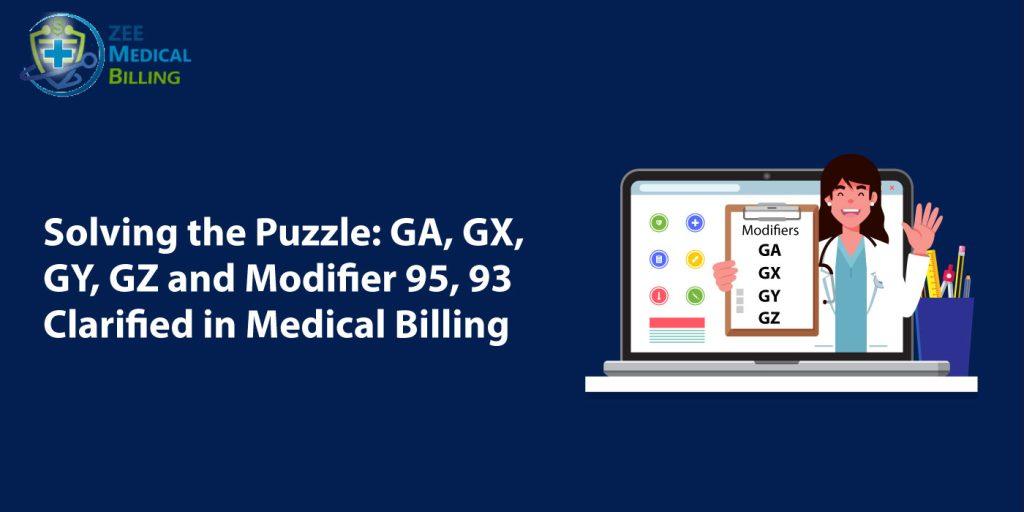In the medical billing field, professionals bill a lot of patients’ data, and medical billing modifiers differentiate these patients. The ABN (Advance Beneficiary Notice) specifies Medicare modifiers to add additional information about the rendered service or procedure. Medicare specifies different types of modifiers among those four most common modifiers that confuse most of the people are GA, GX, GY, and GZ modifiers. We’ll also see some other CPT modifiers like modifiers 95 and 93. So let’s see all those modifiers in detail and let your confusion to an end.
Why are Modifiers Important?
Modifiers are important for the providers to give more clear and concise information about the rendered services. Their main purpose is to clarify any confusion for related services. They help clarify specific details such as the circumstances of the service, location, or level of complexity, which can impact reimbursement rates and payer policies. Then modifiers also impact the payment of healthcare providers. Correct usage ensures proper reimbursement and reduces the risk of claim denials.
GA Modifier:
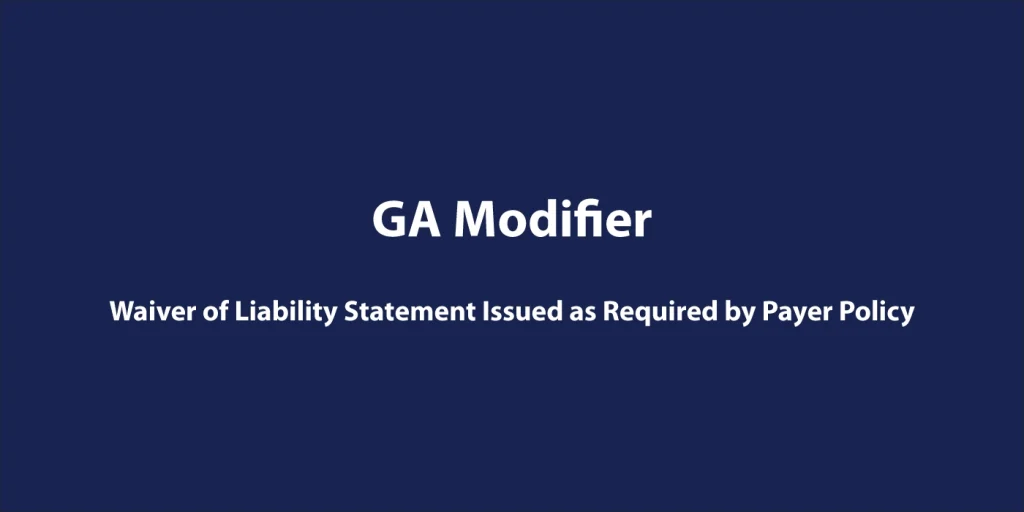
Healthcare providers utilize the GA modifier to indicate that an Advance Beneficiary Notice (ABN) is on file for a certain item or service. This modifier is necessary if there is a chance that Medicare will deny coverage for a service or item because it does not meet the standards of medically necessary care as defined by the Medicare program.
Purpose of GA Modifier
The use of the GA modifier serves to notify Medicare that the beneficiary has received notification about the potential denial of coverage and has consented to accept financial responsibility should Medicare reject their claim. Providers can guarantee that Medicare will automatically assign financial responsibility to the claim after denial by adding the GA modifier to the claim.
When to Use the GA Modifier?
The GA modifier should be used in specific situations where there is a risk of denial from Medicare. These situations include:
Medically Unnecessary Services: When a good or service is unlikely to meet Medicare’s criteria for being deemed medically essential.
Beneficiary Notice in Advance (ABN): when the patient has received an ABN explaining what they have to pay and the possibility of a rejection.
The patient refuses to sign an ABN: The GA modifier can be used to show that the notice was given even if the patient declines to sign the ABN.
Assigned and Unassigned Claims
Both assigned and unassigned claims are eligible for the GA modifier. Whereas the provider does not accept the Medicare-approved amount and can charge the patient up to the limiting fee for unassigned claims, the provider agrees to accept the Medicare-approved amount as full payment for assigned claims.
How to Properly Apply the GA Modifier
Applying the GA modifier requires meticulous attention to detail. Here are the steps to ensure proper usage:
Step 1: Issue an Advance Beneficiary Notice (ABN)
Give the patient an ABN before starting the process or delivering the items in question. The ABN must list the specific item or service, explain why Medicare may not cover it, and provide an estimate of the costs for which the patient will be liable if Medicare denies the claim.
Step 2: Record the Patient’s Recognition
Make sure the patient signs the ABN as a sign of acknowledgment. Even if the patient declines to sign, you should still proceed with the GA modification.
Step 3: Include the GA Modifier
Add the GA modifier to the relevant procedure code when filing the claim with Medicare. This indicates that the patient has been notified of their potential financial responsibility and that the ABN is on file.
GX Modifier:
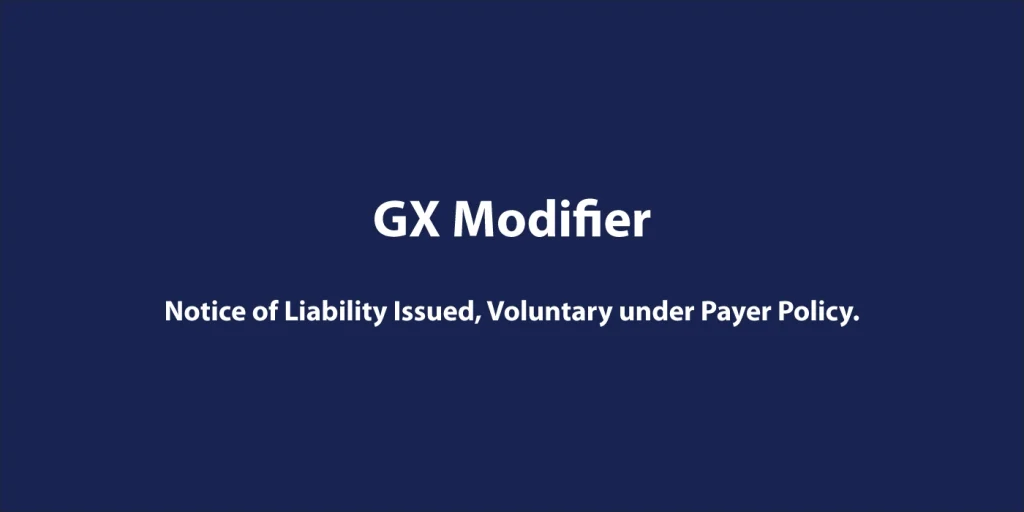
When a patient receives a voluntary Advance Beneficiary Notice (ABN) for services that Medicare does not pay, the GX modifier is used to signify this. This modification makes it clearer what the patient is responsible for and guarantees that the patient has been told about any possible non-coverage.
Purpose of GX Modifier
Healthcare professionals apply GX modifiers to services that Medicare does not cover. They use this modifier to inform patients that they will be financially responsible for the non-covered treatment and that an Advance Beneficiary Notice (ABN) has been voluntarily provided.
Automatic Rejection of Claims
Medicare will immediately reject the claim if any covered charges have the GX modifier added to them. This feature ensures that healthcare professionals only bill the patient for non-covered treatments after receiving the patient’s explicit authorization and understanding.
When to Use the GX Modifier
In some situations where Medicare does not cover the offered service, the GX modifier should be applied. These situations consist of:
Voluntary ABN Issuance: This occurs when a healthcare professional notifies a patient that a treatment is not covered by Medicare by issuing a voluntary ABN.
Non-Covered Services: Services Explicitly prohibited from Medicare coverage, such as elective surgery or cosmetic operations, are referred to as non-covered services.
Combining the GX Modifier with Other Modifiers
Healthcare professionals can combine the GX modifier with certain other modifiers to provide additional context.
GY Modifier: Used to indicate that the item or service is statutorily excluded or does not meet the definition of any Medicare benefit.
TS Modifier: Used for follow-up services.
However, the GX modifier will result in a rejection if submitted with the following modifiers:
EY: No physician or other licensed health care provider orders for this item or service.
GA: Waiver of liability statement issued as required by payer policy, individual case.
GL: Medically unnecessary upgrade provided instead of a non-upgraded item, no charge, no ABN.
GZ: Item or service expected to be denied as not reasonable and necessary.
KB: Beneficiary requested an upgrade for ABN, more than four modifiers were identified on the claim.
QL: Patient pronounced dead after ambulance called.
TQ: Basic life support transport by a volunteer ambulance provider.
How to Properly Apply the GX Modifier
Careful attention to detail is necessary when applying the GX modifier to guarantee compliance and correct invoicing. The methods to using the GX modifier correctly are as follows:
Step 1: Issue a Voluntary ABN
Give the patient a voluntary ABN before administering the non-covered service. The ABN should specify the anticipated cost that the patient would be paying for and explicitly mention that the treatment is not covered by Medicare.
Step 2: Acknowledge the patient
Make sure the patient signs the ABN as a sign of acknowledgment. To ensure that the patient is aware of their financial responsibility, this step is essential.
Step 3: Append the GX Modifier
Add the GX modifier to the relevant procedure code when filing the claim with Medicare. This action indicates that a voluntary ABN has been granted and that Medicare does not cover the service.
GY modifier
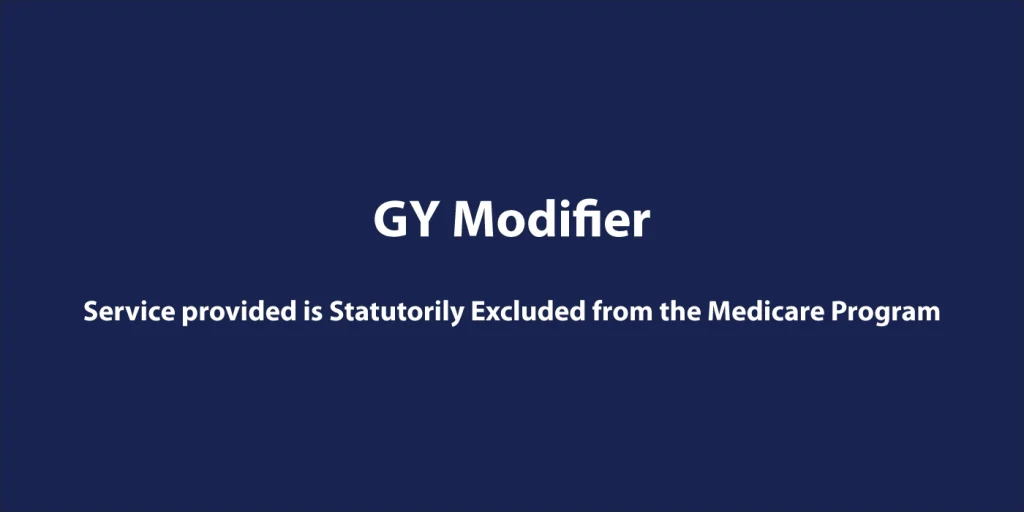
When a service or item is statutorily excluded from Medicare coverage, it is indicated with the GY modifier. Services that are legally prohibited from being covered by Medicare are known as statutorily excluded services. This modifier is essential for differentiating treatments that Medicare deems unreasonable and unnecessary from those that are statutory exclusions.
Purpose of GY Modifier:
The GY modifier’s main use is to indicate treatments that Medicare does not cover because of legislative exclusions. Providers indicate that a service is legally excluded and not covered by Medicare by adding the GY modifier to a claim.
When to Apply the GY Modifier
In some situations where the service rendered is statutorily prohibited from Medicare coverage, the GY modifier should be used. Among these scenarios are:
Statutorily Excluded Services: Examples of statutorily excluded services include cosmetic surgery, hearing aids, and basic dental treatment.
Services Not Listed as Medicare Benefits: The GY modifier should be added to any goods or services that do not fulfill the criteria for being listed as Medicare benefits.
Impact of the GY Modifier on Claims Processing
Beneficiary Liability
The use of the GY modifier clarifies that Medicare does not cover the service, making the recipient responsible for the payment. This transparency guarantees that patients understand their financial obligations and helps to prevent uncertainty.
Processing Claims with Efficiency
When a denial is required for secondary insurance purposes, including the GY modifier might help speed up the denial procedure. This modification facilitates a faster resolution, lessens administrative load, and streamlines the claims procedure.
GZ modifier:
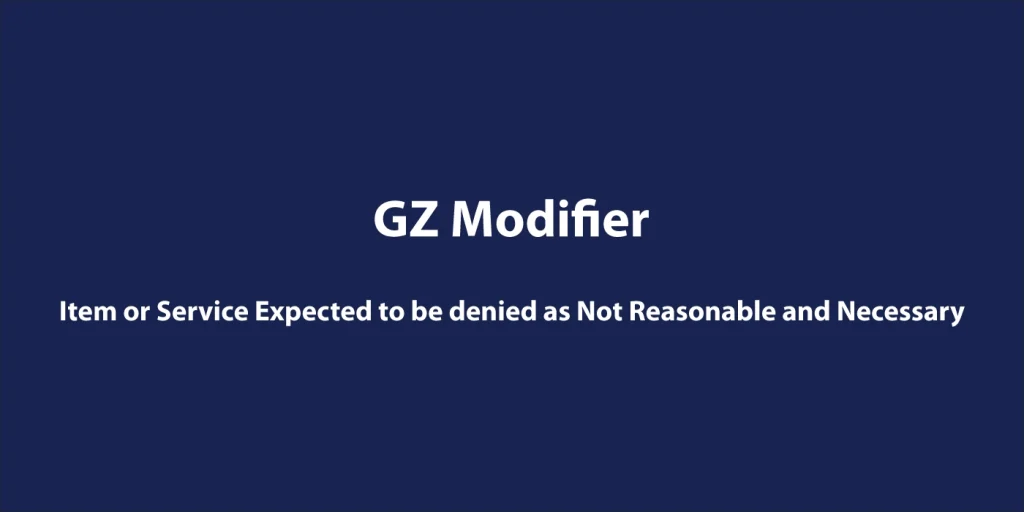
The GZ modifier is used to signal that Medicare doesn’t intend to cover a service or item because it isn’t considered essential or reasonable. When the GZ modifier is included in a claim, it indicates that no Advance Beneficiary Notice (ABN) was sent and that the provider anticipates Medicare to reject payment for lack of medical necessity.
What does the term 'medical necessity' signify?
Healthcare services or supplies that fulfill recognized medical standards and are required for the diagnosis or treatment of an illness, accident, condition, disease or its symptoms are referred to as medically essential services. Medicare will not consider the services to be reasonable and essential if they do not fulfill these requirements.
When to Apply the GZ Modifier?
In some situations, if Medicare is likely to reject the treatment because it is not medically necessary, the GZ modifier should be applied. Among these scenarios are:
Non-Medically Necessary Services: When a provider is aware that a treatment does not fit Medicare’s definition of medical necessity.
No ABN Issued: When the patient was not given an Advance Beneficiary Notice before receiving the service.
Making Claims Submissions Using the GZ Modifier
Claims that are anticipated to be rejected can be processed more quickly by using the GZ modification. It offers clear proof that the provider expects the refusal and that an ABN was not given.
Impact of the GZ Modifier
Provider Liability
The provider’s expectation of a rejection based on medical necessity is made clear by the use of the GZ modifier. The refusal message will indicate that the provider bears the financial responsibility, leaving the patient out of pocket.
Effective Settlement of Claims
Medicare handles GZ modifier claims in the same way as regular claims, however the line item will be immediately denied. This automated rejection clarifies the denial reasons and simplifies the claims adjudication procedure.
Modifier 95
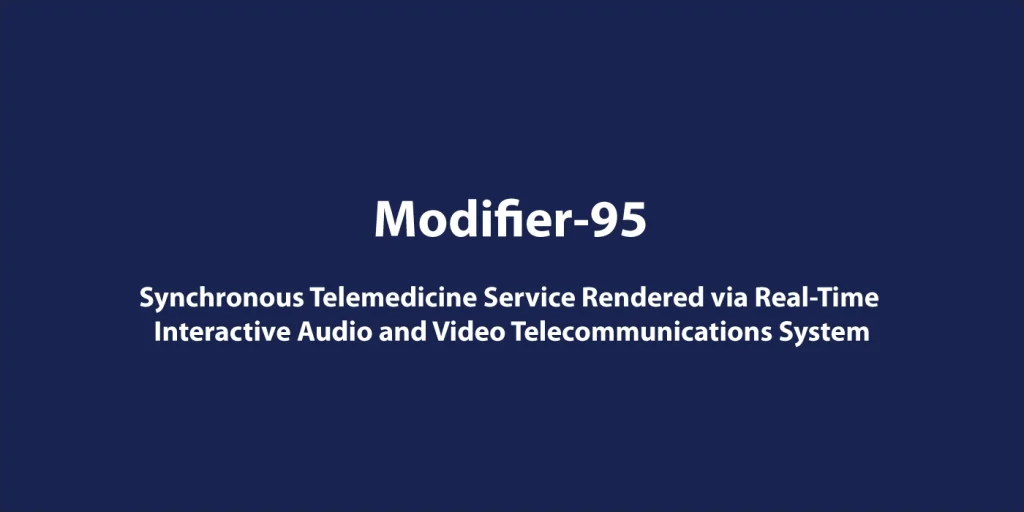
Modifier 95 denotes the delivery of real-time interactive audio and video services using synchronous telecommunication technology. This modifier is necessary to differentiate telehealth services from in-person services, ensuring accurate claim processing and proper payment to providers.
Purpose of Modifier 95
Modifier 95’s main goal is to identify the telehealth services provided during the COVID-19 PHE. Providers notify Medicare Administrative Contractors (MACs) that a telehealth service was provided by adding Modifier 95 to the relevant CPT/HCPCS Level II codes. This is necessary to ensure correct reimbursement under the non-facility provider fee schedule.
Practice Costs and POS Codes
Place of Service (POS) code 02 activates the facility provider fee schedule, which excludes the provider’s practice costs. CMS advises providers who typically offer office services to utilize POS code 11 for telehealth services during the COVID-19 PHE in order to resolve this. However, one must include Modifier 95 in the claim to differentiate between in-person and telehealth services.
When to Apply Modifier 95
In circumstances where telehealth services are provided, healthcare professionals should apply modifier 95. Among these scenarios are:
Encounters with Telehealth: When a provider provides services through telehealth during the COVID-19 pandemic.
Non-Facility Setting: When services are delivered from a location other than a facility, such as the provider’s office.
Modifier 93
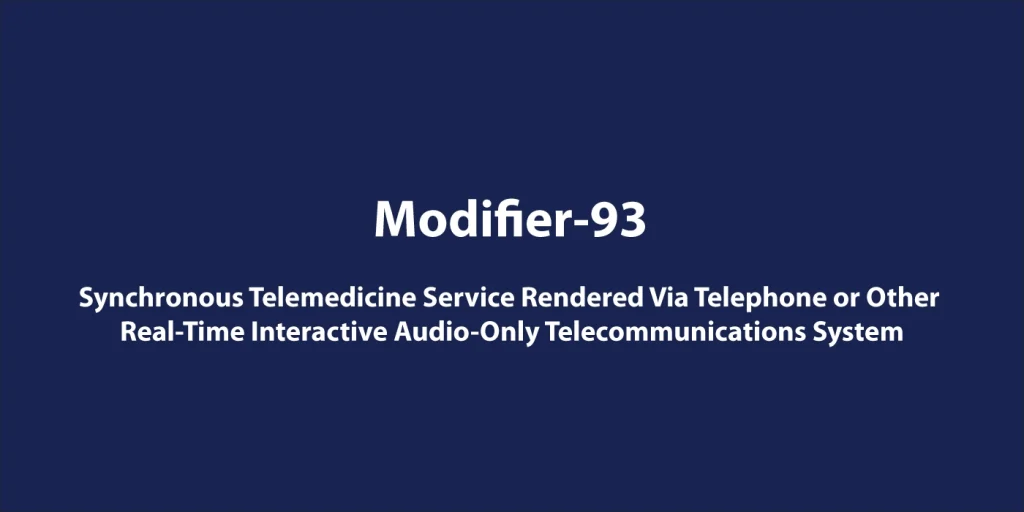
Modifier 93 indicates that a healthcare professional and a patient have conducted an interactive, real-time audio-only conversation to provide a telemedicine service. This modifier distinguishes the service from other telehealth types that may include visual contact by ensuring recognition as telemedicine even without video usage.
Synchronous Telemedicine Service Concept
With synchronous telemedicine, a patient at a different location can communicate in real-time with a doctor or other licensed healthcare provider. The fact that this engagement is happening in real time means that the patient and the practitioner may respond and communicate with each other right away.
Communication Requirements
The information shared during telemedicine services needs to be extensive enough to fulfill the essential elements and specifications of the same service when given in person. Thus, it should be possible to get all relevant data, make clinical judgments, and deliver appropriate treatment through an audio-only conversation just as easily as through a face-to-face interaction.
When to Use Modifier 93
Modifier 93 should be used in specific situations where telemedicine services are provided via real-time interactive audio-only communication. These situations include:
Patients Without Video Access: Patients who need real-time consultation but do not have access to video technology.
Clinical Scenarios That Are Good for Audio-Only: When the nature of the consultation permits sufficient assessment and management by audio-only means.
Regulatory Permits: When certain services or patient groups are allowed by rules to employ audio-only telemedicine.
Frequently Asked Questions
The GA Modifier indicates that an Advance Beneficiary Notice (ABN) is on file for a service expected to be denied by Medicare as not medically necessary. This modifier ensures that Medicare will automatically assign the beneficiary liability upon denial of the claim.
The GX Modifier should be used to indicate that a voluntary ABN was issued for services that are not covered by Medicare. This ensures that claims with the GX Modifier will be automatically rejected for covered charges but allows documentation that the patient was informed of their financial responsibility.
The GY Modifier is used to indicate that an item or service is statutorily excluded from Medicare coverage or does not meet the definition of a Medicare benefit. This results in an automatic denial, and the beneficiary may be liable for all charges.
The GZ Modifier is used when a provider expects that Medicare will deny payment for an item or service due to a lack of medical necessity, and no ABN was issued. It results in an automatic denial with the provider being held liable for the payment.
Modifier 93 is specifically used for synchronous telemedicine services rendered via audio-only communication, whereas Modifier 95 is used for telehealth services involving both audio and video communication. Modifier 93 ensures the service is recognized as telehealth even without video.

